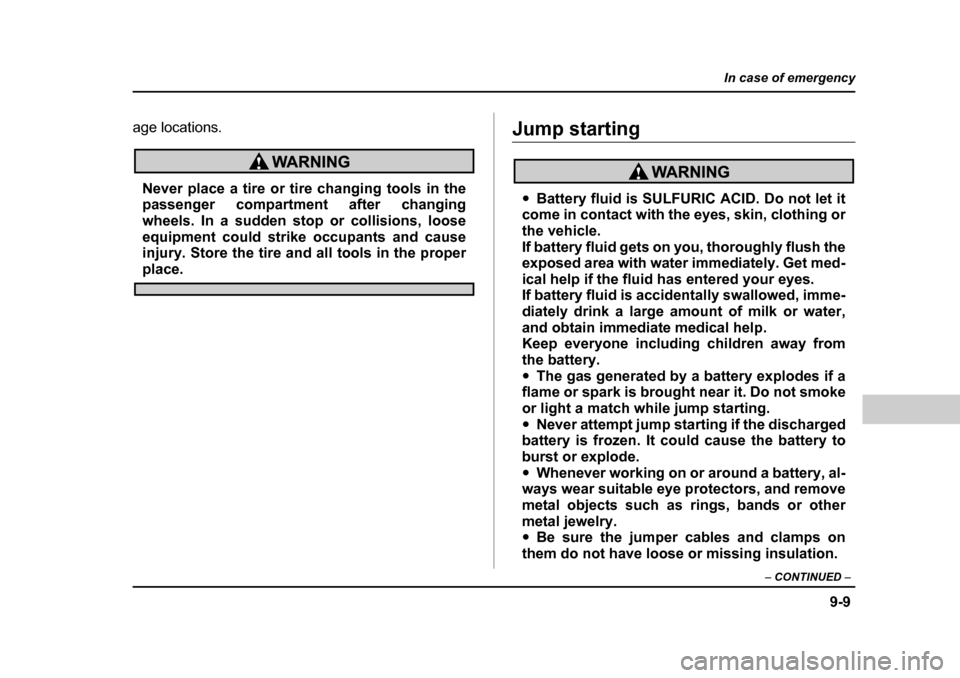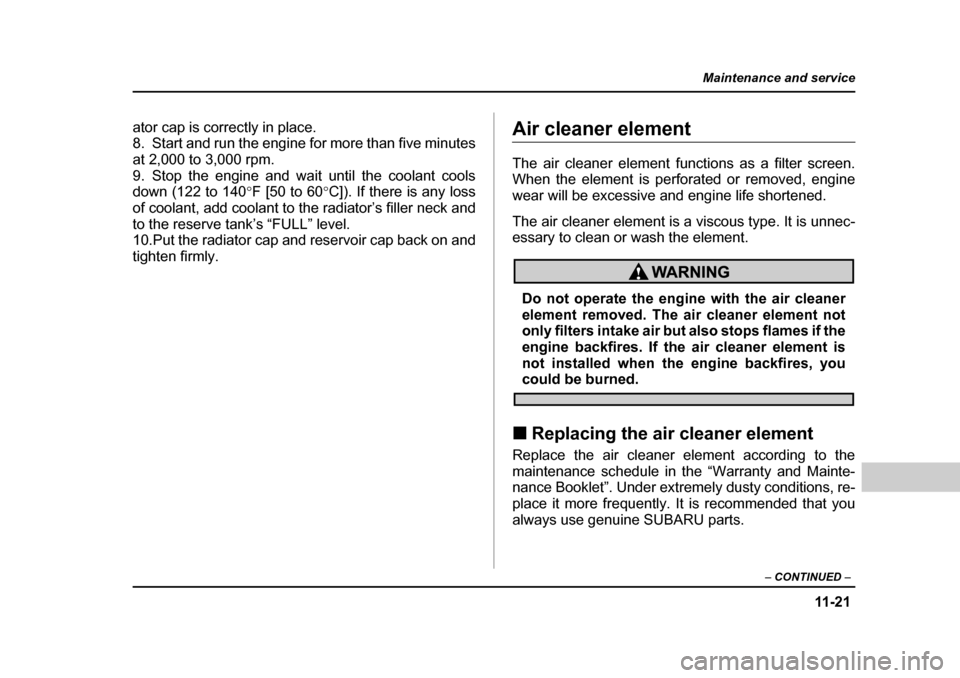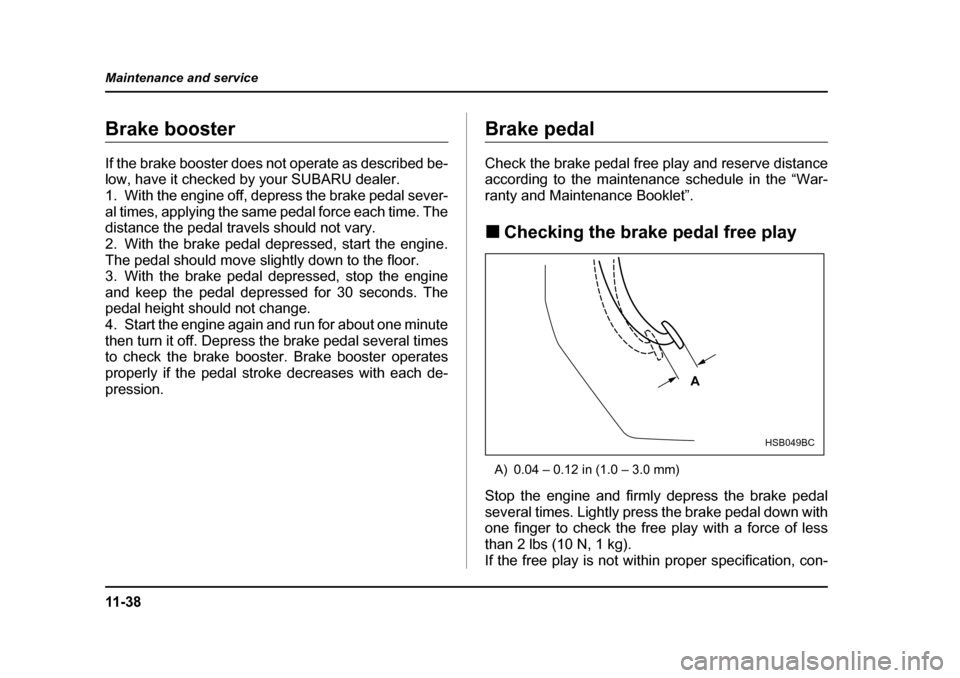Page 346 of 477

9-9
In case of emergency
– CONTINUED –
age locations.
Never place a tire or tire changing tools in the
passenger compartment after changing
wheels. In a sudden stop or collisions, loose
equipment could strike occupants and cause
injury. Store the tire and all tools in the proper
place.
Jump starting
�yBattery fluid is SULFURIC ACID. Do not let it
come in contact with the eyes, skin, clothing or
the vehicle.
If battery fluid gets on you, thoroughly flush the
exposed area with water immediately. Get med-
ical help if the fluid has entered your eyes.
If battery fluid is accidentally swallowed, imme-
diately drink a large amount of milk or water,
and obtain immediate medical help.
Keep everyone including children away from the battery.�y The gas generated by a battery explodes if a
flame or spark is brought near it. Do not smoke
or light a match while jump starting.�y Never attempt jump starting if the discharged
battery is frozen. It could cause the battery to
burst or explode.�y Whenever working on or around a battery, al-
ways wear suitable eye protectors, and remove
metal objects such as rings, bands or other
metal jewelry. �y Be sure the jumper cables and clamps on
them do not have loose or missing insulation.
Page 378 of 477

11 -1 3
Maintenance and service
– CONTINUED –
Never over tighten the oil filter because that can
result in an oil leak.
11.Close the access cover by turning it clockwise and
reinstall the six clips in their original positions.
12.Pour engine oil through the filler neck.
Oil quantity (guideline):
4.2 US qt (4.0 liters, 3.5 Imp qt)
The oil quantity indicated above is only a guideline.
The necessary quantity of oil depends on the quantity
of oil that has been drained. The quantity of drained oil
differs slightly depending on the temperature of the oil
and the time the oil is left flowing out. After pouring oil
into the engine, therefore, you must use the dipstick to
confirm that the level is correct.
13.Start the engine and make sure that no oil leaks ap- pear around the filter’s rubber seal.
14.Run the engine until it reaches the normal operat-
ing temperature. Then stop the engine and wait a few
minutes to allow the oil drain back. Check the oil level
again and if necessary, add more engine oil. �„
Recommended grade and viscosity
Oil grade:
ILSAC GF-3, which can be identified with the new
API certification mark (Starburst mark)
or API classification SL with the words “ENERGY
CONSERVING” (if you cannot obtain the oil with
SL grade, you may use SJ grade “ENERGY CON-
SERVING” oil).
These recommended oil grades can be identified by
looking for either or both of the following marks dis-
played on the oil container.
Oil filter color Part number Amount of rotation
Black 15208AA080 1 rotation
White 15208AA09A 2/3 – 3/4 rotation
Page 386 of 477

11 -2 1
Maintenance and service
– CONTINUED –
ator cap is correctly in place.
8. Start and run the engine for more than five minutes
at 2,000 to 3,000 rpm.
9. Stop the engine and wait until the coolant cools
down (122 to 140 °F [50 to 60 °C]). If there is any loss
of coolant, add coolant to the radiator’s filler neck and
to the reserve tank’s “FULL” level.
10.Put the radiator cap and reservoir cap back on and
tighten firmly.Air cleaner element
The air cleaner element functions as a filter screen.
When the element is perforated or removed, engine
wear will be excessive and engine life shortened.
The air cleaner element is a viscous type. It is unnec-
essary to clean or wash the element.
Do not operate the engine with the air cleaner
element removed. The air cleaner element not
only filters intake air but also stops flames if the
engine backfires. If the air cleaner element is
not installed when the engine backfires, you
could be burned.
�„ Replacing the air cleaner element
Replace the air cleaner element according to the
maintenance schedule in the “Warranty and Mainte-
nance Booklet”. Under extremely dusty conditions, re-
place it more frequently. It is recommended that you
always use genuine SUBARU parts.
Page 403 of 477

11 - 3 8
Maintenance and service
Brake booster
If the brake booster does not operate as described be-
low, have it checked by your SUBARU dealer.
1. With the engine off, depress the brake pedal sever-
al times, applying the same pedal force each time. The
distance the pedal travels should not vary.
2. With the brake pedal depressed, start the engine.
The pedal should move slightly down to the floor.
3. With the brake pedal depressed, stop the engine
and keep the pedal depressed for 30 seconds. The
pedal height should not change.
4. Start the engine again and run for about one minute
then turn it off. Depress the brake pedal several times
to check the brake booster. Brake booster operates
properly if the pedal stroke decreases with each de-pression.Brake pedal
Check the brake pedal free play and reserve distance
according to the maintenance schedule in the “War-
ranty and Maintenance Booklet”. �„
Checking the brake pedal free play
A) 0.04 – 0.12 in (1.0 – 3.0 mm)
Stop the engine and firmly depress the brake pedal
several times. Lightly press the brake pedal down with
one finger to check the free play with a force of less
than 2 lbs (10 N, 1 kg).
If the free play is not within proper specification, con-
A
HSB049BC
Page 405 of 477
11 - 4 0
Maintenance and service
�„
Checking the clutch pedal free play
A) 0.16 – 0.51 in (4.0 –13.0 mm)
Lightly press the clutch pedal down with your finger
until you feel resistance, and check the free play.
If the free play is not within proper specification, con-
tact your SUBARU dealer.Hill holder (MT vehicles – if equipped)
Ensure that the hill holder operates properly under the following circumstances:
1. Stop the vehicle on an uphill grade by depressing
the brake pedal and clutch pedal, with the engine run-
ning.
2. Make sure that the vehicle does not move back-
ward even after the brake pedal is released.
3. Then make sure the vehicle starts climbing the
grade by following the normal starting procedures.
If the hill holder does not operate as described above,
contact with your SUBARU dealer.
A
HSB049BC
Page 471 of 477

14-4
Index
Starting ........................................................... 7-9
Stopping ....................................................... 7-12
Exterior care ...................................................... 10-2 F
Flat tires .............................................................. 9-3
Floor mat ........................................................... 6-15Fluid level Automatic transmission .............................. 11-29
Brake .......................................................... 11-36
Clutch (MT vehicles) ................................... 11-37
Power steering ............................................ 11-34
Fog light button ................................................. 3-27
Front differential gear oil (AT vehicles) ............ 11-31
Front seatbelt pretensioners .............................. 1-31
Front seats .......................................................... 1-2 Fore and aft adjustment ........................... 1-3, 1-5
Reclining .................................................. 1-4, 1-7
Fuel ..................................................................... 7-2 Economy hints ................................................ 8-2
Filler lid and cap ............................................. 7-4
Gauge ............................................................. 3-9
Requirements ................................................. 7-2
Fuses .............................................................. 11-60
Fuses and circuits ............................................. 12-6 G
GAWR ............................................................... 8-16
Glove box ............................................................ 6-5
Gross Axle Weight Rating ................................. 8-16
Gross Vehicle Weight Rating ............................ 8-16
GVWR ............................................................... 8-16 H
Hazard warning flasher ....................................... 3-7
Headlight flasher ............................................... 3-24
Headlights ......................................................... 3-23
Headrest adjustment ......................................... 1-12
Heater operation ................................................. 4-6
High beam indicator light ................................... 3-21
Hill holder ............................................... 7-36, 11-40
Horn .................................................................. 3-40 I
Ignition switch ...................................................... 3-3
Illuminated entry ................................................ 2-11
Illumination brightness control ........................... 3-26
Immobilizer indicator light .................................... 2-5
Indicator light ..................................................... 3-12
Inside mirror ...................................................... 3-35
Interior lights ........................................................ 6-2